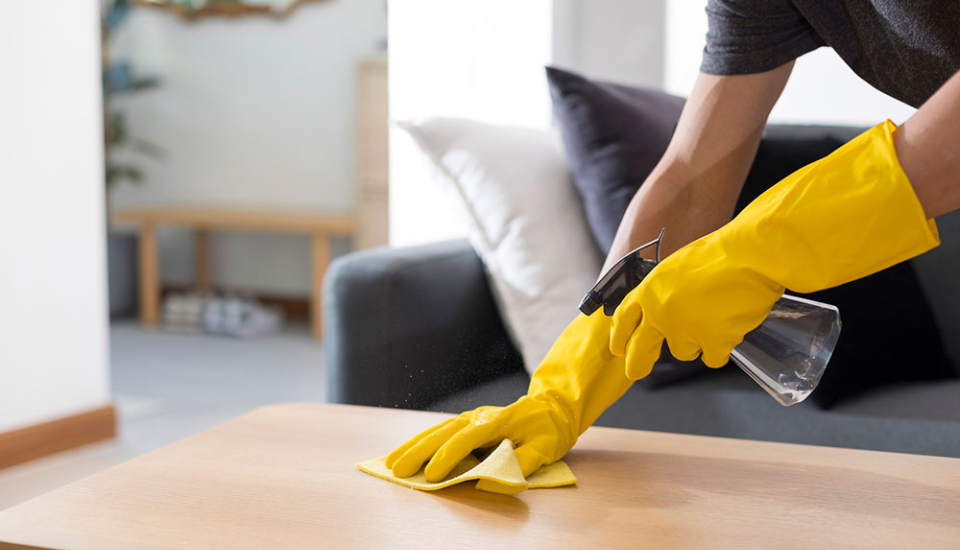
Environmental Monitoring of Nitrates and Other Water Quality Parameters: pH,
Environmental Monitoring of Nitrates and Other Water Quality Parameters: pH,...

Is paramount in today’s day and age. While the world strives to cope with a global pandemic, how do you know that you are sanitizing properly? Or what is the best sanitizer to use? Can you use different sanitizers at the same time? Read on to find out more!
Defined by the FDA, sanitation is “the application of cumulative heat or chemical on a clean food contact surface that, when evaluated for efficacy, is sufficient to yield a reduction of 5 logs which is equal to 99.9999 percent reduction of representative disease microorganisms of public health significance. Sanitation does not only apply to food production, but also to food service, water treatment, breweries, pools & spas, health clubs, paper & pulp, hospitals, and healthcare services among others. In this article, we will be focusing on the application of chemicals for effective disinfection.
One of the key steps to ensuring the effectiveness of sanitation is to start with a clean surface. It is important to recognize the distinction between cleaning and sanitizing. Cleaning focuses on removing oil, grease, and debris from a surface. Sanitizers are responsible for the destruction of microorganisms on the said surface. It is crucial to start with a clean surface before applying a sanitizer because some sanitizers, like chlorine, can react with organic debris, which can render the sanitizer less effective. By cleaning the surface prior to disinfection, we are ensuring maximum contact between the sanitizer and the underlying surface.
One of the key steps of guaranteeing the efficacy of your sanitation plan is choosing the correct type of sanitizer to control for the pathogens of interest-based on risk-assessment—more on that later. There are three additional factors in determining the effectiveness of a sanitizer for a specific application including the concentration of a sanitizer, temperature, and contact time.
Often times, sanitizers are sold as concentrates, and thus must be diluted to a target concentration before use. Industry guidelines, federal regulations, and manufacturer’s instructions are fantastic resources for determining the target concentrations for maximum effectiveness.
Temperatures that are too high or too low can inhibit disinfection efficacy. It is important to consider the temperature of the environment in which the sanitizer will be applied. Most sanitizers work between the ranges of 55-120°F.
Most sanitizers do not kill microorganisms instantly. They require a minimum amount of time where they need to be in contact with the surface. There are general guidelines for contact time based on sanitizer class.
Sanitizers that are improperly mixed will have limited effectiveness, whereas sanitizers that are too strong can be toxic and leave unpleasant residuals in products. It is therefore critical to monitor the concentration of your sanitizers to ensure that they will achieve the intended disinfection in a safe manner. A lot of the focus of this presentation will be to look at the different testing methods for monitoring the concentration of these various sanitizers.
Measurement techniques depend on the active ingredients of the chemical. However, there are several general technologies used to monitor concentration.
Pros: Inexpensive. Easy to use.
Cons: Not very accurate. Very low resolution.
Test strips are strips of paper laced with chemicals that will react with a sanitizer to produce a colour change. The colour of the strip is then compared to a colour chart to determine the concentration. These strips are convenient, easy to use, and relatively inexpensive. The downsides to test strips are that they offer a limited resolution, they are subjective to the user, and they provide little in the way of record keeping.
Pros: Easy to use. Colour change.
Cons: You have to dispose of chemicals. Low resolution.
With some chemical test kits, a sample of a certain size is collected, then chemicals or reagents are added to that sample to form a colour change. Just like with test strips this colour change is then matched to a gradient chart to determine the concentration. Other test kits are small-scale titrations (refer to titration section) where drops of a chemical are added to the sample until a colour change is observed. The number of drops used to produce that colour is then used in a calculation to determine the calculation. Similar to test strips, these methods of analysis are easy-to-use and relatively inexpensive, but again provide limited resolution and are subjective. Waste disposal of any hazardous chemicals may also apply.
Pros: Sometimes portable. More accurate. Sometimes customizable.
Cons: More expensive. Requires more technical know-how.
This technology operates under a similar principle to the chemical test kits. A sample is collected, reagents are added, and a colour change is produced. However, instead of manually assessing the colour based on a chart, an instrument with a photodetector interprets the results and provides a digital readout of concentration. This eliminates the subjectivity and provides more consistent results among operators. These tests can be subject to interferences from coloured or turbid samples as well as competing ions that may be present in the sample. Additional considerations for waste disposal may be necessary depending on the reagents. These instruments can vary in price, depending on the optical sophistication, range of wavelengths, and additional features like logging, which can assist with record keeping.
Pros: Very accurate. Able to run multiple tests.
Cons: Can be expensive. Requires training.
Titration is a technique in which a chemical of a known concentration, “titrant” is added to a sample an analyte of unknown concentration until a colour change or other potentiometric signal occurs. The volume of titrant added is then used in a calculation to determine the concentration of the in order for this to work, the titrant and the analyte must have a known, predictable reaction. Titrations can be performed with droppers (chemical test kits), a manual burette with a stopcock, or via an automatic titration system. Manual titrations, as mentioned can be subjective and offer little in the way of record keeping. Automated systems are much more accurate, reduce inconsistencies between operators, and can export data for verification records. Manual titration setups are relatively inexpensive, whereas automatic systems are typically more of an initial investment.
Pros: Very accurate. Can be used in many types of analyses.
Cons: Has to be used in conjunction with other instrumentation.
Electrochemical sensors are devices that provide information about the composition of a solution. They work through detecting specific analytes or properties of analytes and converting them to an electrical signal that is then translated and displayed on a monitor or meter. A lot of times, calibration with a reference material is required in order to obtain an accurate concentration. pH electrodes, conductivity sensors, dissolved oxygen sensor, ORP (oxidation-reduction potential) electrode, and ion-selective electrodes are all examples of electrochemical sensors.
Pros: Relatively inexpensive. Easy to use.
Cons: It can only be used for a few types of tests.
A hydrometer is an instrument that is used for measuring the specific gravity, or relative density, of solution. It operates based on the principles of buoyancy. A manual hydrometer is a sealed tube that has a narrow stem and a wider base that is filled with mercury or lead to keep it upright when submerged in the solution. The sample to be measured is poured into a tall container, such as a graduated cylinder, and the hydrometer is lowered into the sample until it floats freely. On the stem is a specific gravity scale or a scale specific to an analyte. The height at which the sample reaches the stem is recorded as the measurement. Temperature greatly affects this measurement, so care should be taken to correct for this. Digital hydrometers also exist with built-in thermometers to reduce the user error associated with reading the scale. Some of these digital meters will also have logging functions for record-keeping.
Pros: Can perform multiple tests. Very accurate.
Cons: The most expensive. Requires training to use.
Chromatography is a way of separating individual components of a mixture. A mobile phase with sample is carried through a stationary phase, which causes the components to separate based on various chemical properties including volatility, mass, affinity, etc. The relative proportions of the individual components can then be determined via a specific detector. Common types of chromatography include liquid chromatography–including HLPC, gas chromatography—GC, ion exchange chromatography—IC, etc. These instruments are very accurate but require skilled personnel to achieve good results. Chromatography instruments are relatively expensive ranging from $15,000 for used instrumentation up to $200K+ for new instruments.
With so many options, it can be difficult to determine which method is right for your application.
The following takes a closer look at individual sanitizers. While there are general guidelines provided, it is important to defer to the manufacturer’s recommendations for use.
Iodine is part of the oxidizer class of sanitizers and is commonly known as Iodophors. Iodine is used in a variety of applications. Industries such as food production, dairy, brewing, winemaking, restaurants, healthcare, and aquariums. Iodine concentration, when used as a sanitizer, is between 12.5 ppm and 25 ppm. Iodine can target and or inhibit the growth of bacteria, yeast, mold, fungi, viruses, and protozoans. This sanitizer can be measured via multiple types of testing. These include test strips, chemical test kits, photometry (spectrophotometry), electrochemical sensors, and titration.
Pros:
Cons:
Peroxyacetic acid, also known as peracetic acid (POA or PAA) is an effective oxidizer that is used in a variety of applications, it is notifiable in the food industry. Food processors, breweries, winemaking, restaurants, meat/seafood/poultry disinfection, egg disinfection, paper and pulp manufacturing, healthcare, and produce washing (it is even approved for the production of organic produce). Between 24 to 80 ppm of PAA works great for sanitizing foods when the sanitizer is in direct contact with the item. For sanitizing equipment or surfaces, you can use a higher concentration, between 50 and 500 ppm. PAA is effective against bacteria, yeasts, fungi, and spores. Testing for PAA can be done with different methods, including test strips, photometry (spectrophotometry), electrochemical sensors, and titration.
Pros:
Cons:
Bromine is another sanitizer in the oxidizer family. It’s commonly called hypobromous acid. Bromine is generally used in pools and spas, cooling towers, paper and pulp manufacturing, the meat industry, and in water treatment. The concentration of bromine needed for sanitizing varies by industry/application.
Industry/Application | Bromine Concentration (ppm) |
| Pools and Spas | 1 – 3 |
| Cooling Towers | 2.5 – 15 |
| Industrial Pasteurizers | 1 – 9 |
| Paper and Pulp | 1 – 9 |
| Decorative Fountains | 4.5 – 9 |
| Poultry | 200 – 450 |
| Meat | 300 – 900 |
Bromine is able to target bacteria, fungi, algae, and slime. Testing for bromine can be done with different methods, including test strips, photometry (spectrophotometry), electrochemical sensors, and titration.
Pros:
Cons
Chlorine is the last sanitizer from the oxidizer family that we will talk about. It is also called hypochlorite, and chlorine dioxide. Chlorine can be used in many practical applications for households, drinking water, water treatment, food production, produce washing, meat and poultry processing, egg production, food service, pools and spas, and in aquariums. The concentration of chlorine needed for sanitizing varies by industry/application.
Industry/Application | Chlorine Concentration (ppm) |
| Chlorine as a Sanitizer | 50 – 200 ppm |
| Drinking Water | 1 ppm of residual chlorine |
| Meat and Poultry | 50 – 100 ppm |
| Produce Washing | 40 – 350 ppm (Varies) |
| Pools and Spas |
Chlorine is able to target bacteria, fungi, viruses, and mold. Testing for chlorine can be done with different methods, including test strips, chemical test kits, photometry (spectrophotometry), electrochemical sensors, and titration.
Pros:
Cons:
Quaternary ammonia, also known as QUATs, is part of the surfactant family of sanitizers. When looking at labels you may also see it listed as benzalkonium chloride, benzethonium chloride, alkyl dimethyl benzyl ammonium chloride, alkyl dimethyl ethylbenzyl ammonium chloride, didecyldimethylammonium chloride, or dioctyldimethylammonium chloride. Quaternary ammonia is used in food processors, wine making, household disinfection, meat and poultry farms, food service, healthcare, and aquariums. It is able to target bacteria, fungi, viruses and molds. When using quaternary ammonia always refer to the manufacturer’s specifications when determining what concentration to use. Generally, the concentration is around 200 ppm. Common testing methods to determine the concentration of quaternary ammonia are test strips, chemical test kits, photometers (spectrophotometry), titration, electrochemical sensors, and chromatography.
Pros:
Cons:
Ethanol is a type of alcohol that can be used as a sanitizer. You may hear it called ethyl alcohol or EtOH. It is commonly used in hand sanitizers and in healthcare settings. To be effective, ethanol has to have a concentration between 60% and 95%. Ethanol targets bacteria, fungi, and viruses. Common testing methods to determine the concentration of ethanol are hydrometer, photometry (spectrophotometry), and chromatography.
Pros:
Cons:
In addition to measuring the concentration of a sanitizer, is it crucial to monitor the effectiveness of the disinfection through verification? Verification is a critical step of SSOP (Sanitation Standard Operating Procedures) and GMP (Good Manufacturing Practices), and should not be skipped. Protein swabs and ATP (adenosine triphosphate) bioluminescence swabs are commonly used before and after sanitation to monitor effectiveness. These types of swabs indicate the levels of organic debris and residues on the surface. Positive tests can indicate that sanitation was incomplete, and the surface should be disinfected again before that surface should be used. However, not all organic presence is due to pathogens, as food residues will also be included in these readings. To test the levels of microorganisms present, samples are collected and sent for microbiological testing. A lot of times indicator organisms are used to determine if sanitation was complete because they are easy to test and less expensive. Indicator specimens are often common microbes that share characteristics of the target organism, E. Coli being a common example. Testing for specific pathogens can be performed as well, but they are typically less available and more expensive.
The importance of measuring and monitoring of sanitation is only part of the puzzle. Other considerations for ensuring the safety of your workers and products/services include:
NOTE: Mixing can cause violent chemical reactions.
Environmental Monitoring of Nitrates and Other Water Quality Parameters: pH,...
Salt Concentration In A Brine Solution For Curing Salmon Traditionally,...

To empower customers to achieve quality by supplying intuitive, accurate, and reliable analytical instruments with exceptional customer service and value.
We take pride in every product we build. From an original idea to a completed product ready for testing. We oversee every aspect of the manufacturing process. It is this level of attention to detail that sets us apart.
To empower customers to achieve quality by supplying intuitive, accurate, and reliable analytical instruments with exceptional customer service and value.
We take pride in every product we build. From an original idea, to a completed product ready for testing. We oversee every aspect of the manufacturing process. It is this level of attention to detail that sets us apart.
To empower customers to achieve quality by supplying intuitive, accurate, and reliable analytical instruments with exceptional customer service and value.
We take pride in every product we build. From an original idea, to a completed product ready for testing. We oversee every aspect of the manufacturing process. It is this level of attention to detail that sets us apart.

